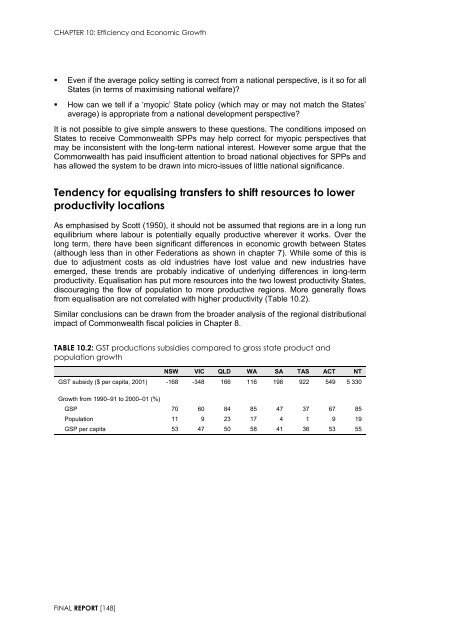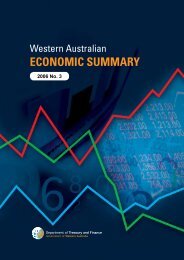Garnaut Fitzgerald Review of Commonwealth-State Funding
Garnaut Fitzgerald Review of Commonwealth-State Funding
Garnaut Fitzgerald Review of Commonwealth-State Funding
You also want an ePaper? Increase the reach of your titles
YUMPU automatically turns print PDFs into web optimized ePapers that Google loves.
CHAPTER 10: Efficiency and Economic Growth<br />
• Even if the average policy setting is correct from a national perspective, is it so for all<br />
<strong>State</strong>s (in terms <strong>of</strong> maximising national welfare)<br />
• How can we tell if a ‘myopic’ <strong>State</strong> policy (which may or may not match the <strong>State</strong>s’<br />
average) is appropriate from a national development perspective<br />
It is not possible to give simple answers to these questions. The conditions imposed on<br />
<strong>State</strong>s to receive <strong>Commonwealth</strong> SPPs may help correct for myopic perspectives that<br />
may be inconsistent with the long-term national interest. However some argue that the<br />
<strong>Commonwealth</strong> has paid insufficient attention to broad national objectives for SPPs and<br />
has allowed the system to be drawn into micro-issues <strong>of</strong> little national significance.<br />
Tendency for equalising transfers to shift resources to lower<br />
productivity locations<br />
As emphasised by Scott (1950), it should not be assumed that regions are in a long run<br />
equilibrium where labour is potentially equally productive wherever it works. Over the<br />
long term, there have been significant differences in economic growth between <strong>State</strong>s<br />
(although less than in other Federations as shown in chapter 7). While some <strong>of</strong> this is<br />
due to adjustment costs as old industries have lost value and new industries have<br />
emerged, these trends are probably indicative <strong>of</strong> underlying differences in long-term<br />
productivity. Equalisation has put more resources into the two lowest productivity <strong>State</strong>s,<br />
discouraging the flow <strong>of</strong> population to more productive regions. More generally flows<br />
from equalisation are not correlated with higher productivity (Table 10.2).<br />
Similar conclusions can be drawn from the broader analysis <strong>of</strong> the regional distributional<br />
impact <strong>of</strong> <strong>Commonwealth</strong> fiscal policies in Chapter 8.<br />
TABLE 10.2: GST productions subsidies compared to gross state product and<br />
population growth<br />
NSW VIC QLD WA SA TAS ACT NT<br />
GST subsidy ($ per capita, 2001) -168 -348 166 116 198 922 549 5 330<br />
Growth from 1990–91 to 2000–01 (%)<br />
GSP 70 60 84 85 47 37 67 85<br />
Population 11 9 23 17 4 1 9 19<br />
GSP per capita 53 47 50 58 41 36 53 55<br />
FINAL REPORT [148]

















